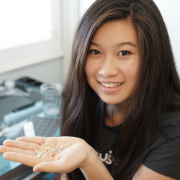
Melanie Quan is a senior from Las Lomas High School in California. Over the past few years, Melanie has done science and engineering projects concerning different areas of plastic pollution, such as their interactions with heavy metals, the removal of microplastics, and the up-and-coming concept of algal bioplastics. Plastic pollution, an issue that is important to her, was her topic of choice once again this summer. Under the guidance of Jace Tunnell, Reserve Director at the University of Texas Marine Science Institute, and Colleen Johnson, Project Scientist at EarthCon Consultants, Inc., Melanie worked on a nurdle research project analyzing citizen scientists’ nurdle reports. Her paper “Analysis of Plastic Pellet Distribution Using Citizen Science Nurdle Patrol Data and Batch Identification to Differentiate Spills Within Samples” details how she identified the types and quantities of these tiny plastic pellets in the Gulf Coast of Texas, and what this could mean for pollution policy in the state and across the country.
Melanie’s work began at her summer research program RSI, or Research Science Institute. Here, she got to hear presentations from Nobel laureates and other field experts, attend classes taught by professors from various universities, and conduct her own research project with help from mentors and alumni. Her mentors Jace Tunnell and Colleen Johnson guided her during the process, both with understanding the reach and severity of nurdle pollution, and with preparing the strategies she used to analyze Nurdle Patrol data. In addition, RSI counselors and tutors, such as PhD candidate Ana Lyons and RSI alum Edward Hu, supported her along the way. Because of the pandemic this year, RSI had to be adapted to have lectures and meetings completely online. Despite this, Melanie had a couple standout experiences away from the screen, which were analyzing specific nurdle batches at a lab in Fremont, California, as well as going nurdle patrolling at some nearby beaches.
To begin her analysis, Melanie was searching for a link between the concentration of nurdles and their distance from plastic plants, where they are sourced and spilled, and railroad crossings, where they are released during transport. She chose to look at three different 50 square mile regions along the Texas Gulf Coast, near Corpus Christi, Galveston, and Bay City, which had a high number of nurdle reports. After graphing the distance from reports in these areas to manufacturing and transportation sites, which she got from online public databases, Melanie’s results showed weak correlations. She reached a qualified conclusion that the distance between collection sites and both plastic manufacturers and railroad crossings somewhat indicate the amount of nurdles found, but the distance is not a full explanation. Her analysis could potentially mean that nurdles are travelling significantly further from pollution sources. She expressed that this aspect could be further studied by considering other environmental variables such as currents, geography, and weather.
Melanie then aimed to identify the different types of plastics that make up nurdles found at collection sites. Nurdles are pre-production pellets, created in batches for a certain manufacturing purpose, so different chemical makeups in one collection site means that there have been multiple spills there. She used Fourier-Transform Infrared Spectroscopy, or FTIR analysis, to determine the chemical compositions of plastics, and used physical appearance such as shape, color, and size to further differentiate batches. The most common type of plastic by far was LDPE, or Low Density Polyethylene, which is used in packaging, insulation, toys, shopping bags, and more. LDPE does not degrade easily in the environment and is highly buoyant, some reasons why it may have been found more often. In total, Melanie ended up defining 89 batches over nine samples, with the most batch variety in the Southern samples. She says that finding this huge number of batches, indicating that copious nurdle spills have reached a single area rather than one large spill, was “the biggest surprise—and the significance of the research.” Melanie writes in her report that her findings are relevant to policy, or lack-there-of, placing restrictions on manufacturing companies to prevent spills and release of nurdles, and ends her paper by saying that more effective policy can minimize nurdle pollution.
In February 2020, Nurdle Patrol published their own paper on the methodology of conducting nurdle reports in a standardized way. It included regulations like spending 10 minutes searching at a high tide line, as well as further information on how the data can inform plastic pollution policy. This standardization has allowed for further research and analysis of Nurdle Patrol data, including Melanie’s over the summer. The work of citizen scientists has greatly supported this project, and Melanie considers it an honor to be able to use this work to find a bigger picture about nurdle pollution. She marvels at the fact that “there have really been thousands of people who have worked to collect samples and data that were used for this project.” With this data, Melanie has uncovered the frequency and number of spills that can reach one pollution site, backing Nurdle Patrol’s cause to get clearer pollution policy in Texas and across the country. Melanie hopes to continue using her knowledge of science and engineering to work towards environmental remediation and sustainability in the future.
------------------------------------------------------------------------
About the author: Arya Das is a high school student from the San Francisco Bay Area. She is currently a senior, and plans to major in environmental engineering and work in pollution prevention or renewable energy after college. Arya works with reserve director Jace Tunnell to write articles for the citizen science project Nurdle Patrol.
| melanie_quan_final_paper.pdf | 2.5 MB |

